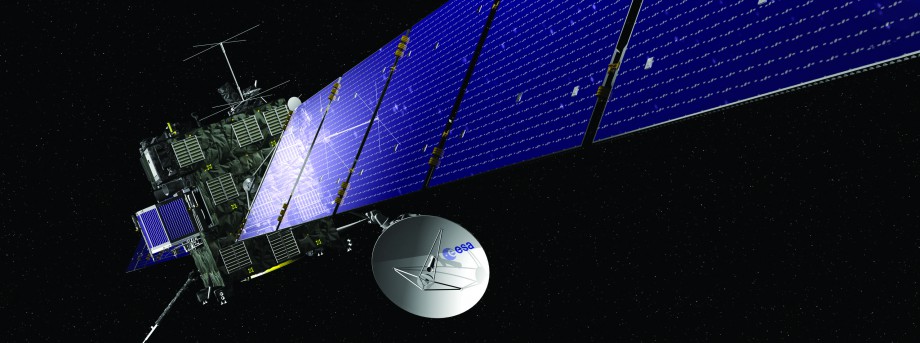The University of Nottingham
 Exchange online
Exchange online
Research Exchange
Rosetta and Nottingham’s role in the history of space exploration

August 4 2014
On Wednesday 6 August, a spacecraft will make history as it goes into orbit around a comet. Rosetta will be the first spacecraft to meet a comet and accompany its orbit around the sun, before landing a probe on the comet’s surface.
Among those following the European Space Agency’s (ESA) Rosetta mission are Nottingham scientists whose pioneering research contributed to making this technically demanding flight a success.
The rocket engines that will manoeuvre the unmanned Rosetta into position around Comet 67P/Churyumov-Gerasimenko as it hurtles across space use a UK-produced propellant known as N2O4, which benefited greatly from early research at The University of Nottingham.
Liquid nitrogen oxides such as N2O4 had been studied at Nottingham’s School of Chemistry since the late 1940s. Twenty years later, it was interest from NASA that led to Nottingham playing a significant part in space exploration.
In 1969, the year of the Apollo moon landing, American space scientists continued to have problems with impurities in the liquid N2O4 propellant that were causing blockages in the filters and propellant lines of NASA’s rockets. They turned to Nottingham researchers for help. The School of Chemistry’s late Professor Clifford Addison and Dr Norman Logan helped to identify the problems in the propulsion systems were caused by tiny amounts of iron nitrate formed by corrosion of stainless steel components in the propellant system.
In 2009, marking Nottingham’s role in the 40th anniversary of the moon landings, Dr Logan said: “Since the Apollo era a large number of space craft using liquid N2O4 propellant, such as the Space Shuttle, and numerous communications satellites, have benefitted from the research carried out at The University of Nottingham. This work spanned 50 years from 1947 to 1997.”
Dr Logan, who is now retired, added: “It is great but no surprise that N2O4 is still the propellant of choice of the Rosetta space probe.”
Dr Barrie Mellor was a member of Dr Logan’s propellant research team in the 1980s and subsequently went to work for the Royal Ordnance Company at Westcott, Buckinghamshire. Royal Ordnance further refined the methods used to purify the propellant, and went on to establish the largest facility in Europe for manufacturing it.
Dr Mellor, who now operates the Edotek consultancy which specialises in propellant chemistry, said: “The N2O4 produced at Westcott has been used on a very large number of European spacecraft, including the European Space Agency’s flagship missions, CLUSTER, Mars Express, Venus Express and Rosetta”
During its 11-year mission Rosetta used the Earth’s and Mars’ gravitational pull to ‘slingshot’ through space and its N2O4-fuelled rockets were not fired for years at a time. When it manoeuvres to within 1-2km of the 4km-wide comet as it hurtles across space, ESA scientists need absolute confidence in the performance of its thrusters.
In the most detailed study of a comet ever attempted, Rosetta will orbit 67P for 17 months and in November will landing its robotic probe on its surface to take further samples and photographs. It has been sending ever-clearer photographs of the comet back to Earth and these can be seen at the ESA website.
“Achieving such long-duration space missions depends critically on using propellant which has been manufactured to very high standards of purity,” said Dr Mellor. “The Westcott propellant, produced using techniques which evolved from the methods used at Nottingham, set new standards of purity and has proved worthy of the confidence which ESA placed in it. I have been following the flight of Rosetta and it very rewarding that the work we did on propellants at Nottingham is part of its heritage.”
A short film about The University of Nottingham’s rocket fuel research as part of its Periodic Table of Videos.
Tags: Churyumov-Gerasimenko, Comet 67P, Dr Barrie Mellor, Dr Norman Logan, European Space Agency, Liquid nitrogen oxides, N2O4, NASA, Professor Clifford Addison, propellant, rocket engines, rocket fuel, Rosetta, Royal Ordnance Company, School of Chemistry, spacecraft
Leave a Reply
Other News

Top prize for quantum physicist
A University of Nottingham physicist has won a prestigious medal from the Institute of Physics for […]

Zero carbon HOUSE designed and built by students comes home
Design and construct a low cost, zero carbon, family starter home, transport it to Spain, build […]